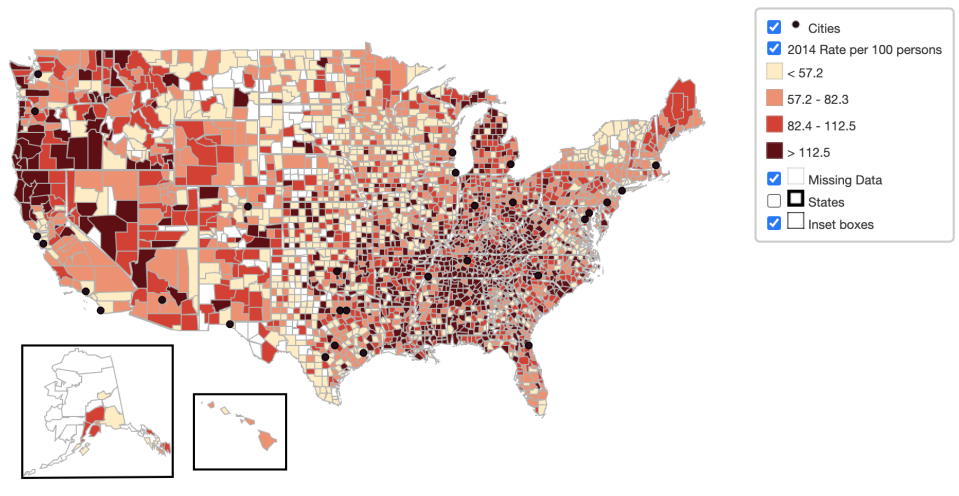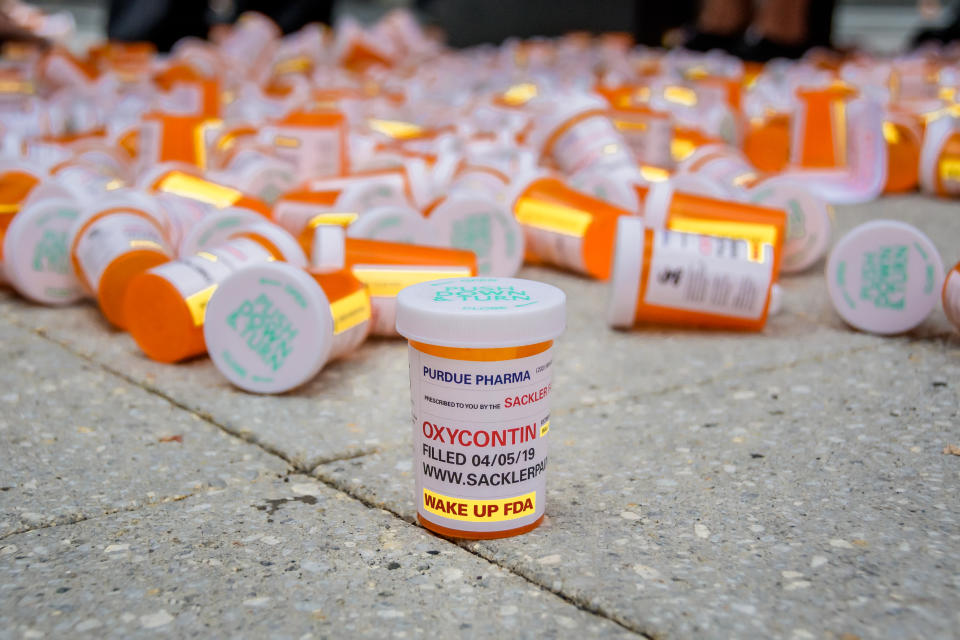Opioid crisis to cost $2.15 trillion? ‘No amount of money can ever compensate for the pain’
U.S. states are claiming that opioid manufacturers, distributors, and others who fueled the country’s decades-long opioid crisis will cost the economy at least $2.15 trillion by the year 2040.
The figure was reported in a filing made public Monday in the Southern District of New York in the bankruptcy case for OxyContin maker Purdue Pharmaceutical.
“The opioid epidemic has ravaged this country as a single family has made billions profiting from the destruction it caused,” New York Attorney General Letitia James said in a statement emailed to Yahoo Finance. “The millions of families that have suffered as the result of addiction, ailments, and death can never be repaid for their losses, and no amount of money can ever compensate for the pain that so many now know.”

Between 2007 and 2019, the states estimated that their systems took a $630 billion hit. Anticipated costs of $1.53 trillion from 2020 to 2040 are estimated to run up the rest of the tab.
“As expected,” a Purdue spokesperson stated, “claims have been filed by a variety of private and public entities, including the states and territories, and it is typical for claims to be filed in amounts substantially larger than what is ultimately allowed by the court.”
The company, which filed for bankruptcy in September amid mounting lawsuits against opioid supply chain participants, proposed delivering more than $10 billion in value — including 100% of Purdue’s assets — toward claimants, communities, opioid addiction treatment, and overdose reversal medicines.
‘An extraordinary number of people are taking opioids’
In December 1995, the FDA approved a new opioid known as Oxycodone. Subsequently, according to the National Institute on Drug Abuse, “pharmaceutical companies reassured the medical community that patients would not become addicted to prescription opioid pain relievers, and health care providers began to prescribe them at greater rates.”
The cost of millions of Americans becoming addicted to prescription opioids on the country’s economy has not gone unnoticed. Last year, while testifying before the House Financial Services Committee, Federal Reserve Chair Jerome Powell spoke of its effects on the workforce.
“An extraordinary number of people are taking opioids in one form or another and it weighs on labor force participation,” Powell said. “It’s a national crisis, really. The humanitarian crisis of it is completely compelling but the economic impact is also quite substantial.”

The crisis has also cost a fortune in lost tax revenue: Between 2000 and 2016, “opioid misuse cost state governments $11.8 billion, including $1.7 billion in lost sales tax revenue and $10.1 billion in lost income tax revenue,” according to a study conducted by researchers at Penn State University. The study also found that the federal government lost $26 billion in income tax revenue during that time span.
With the exception of Oklahoma, which reached a settlement with Purdue in 2019, and claims from Kentucky prior to 2016, the more than $2 trillion represents the estimated past and future financial toll that U.S. states, the District of Columbia, and U.S. territories believe distributors and manufacturers have inflicted on the country’s health care, criminal justice, child welfare, educational, and workforce infrastructures.
A breakdown of the numbers
Harvard Law School professor Mark Roe said the states’ claims, if validated by the bankruptcy court, would share proportionately with all other claims on Purdue. He added that the large size of the claim could signal sizable demands in cases pending against other opioid defendants, which in turn would leave fewer funds for individual plaintiffs.
“That would mean that the plaintiffs will eventually get less than they thought they would yesterday because they would have to share with the states,” Roe said.
And while the states recognize that their financial damage claims far outweigh any realizable remuneration achievable through Purdue’s bankruptcy or otherwise, the data will undoubtedly catch the attention of the cast of opioid supply chain participants embroiled in pending lawsuits across the country.
On Monday, the Wall Street Journal reported that opioid distributors McKesson (MCK), AmerisourceBergen (ABC) and Cardinal Health (CAH), along with opioid manufacturer Johnson & Johnson (JNJ), made a combined $26.4 billion offer to settle with an unidentified number of states. It was previously reported that 21 states turned down an $18 billion settlement offer from the three distributor defendants.

The financial costs in the current claim vary by state — New York and California are the only two states to top $100 billion at $165.8 billion and $192.1 billion, respectively.
Below are the financial costs claimed by each state and U.S. territory. The claims do not include amounts unknown or unforeseen to the states at the time of the filing.
Alabama -- $35,331,000,000
Alaska -- $8,942,000,000
Arizona -- $55,792,000,000
Arkansas -- $20,983,000,000
California -- $192,092,000,000
Colorado -- $39,886,000,000
Connecticut -- $50,686,000,000
Delaware -- $15,756,000,000
District of Columbia -- $9,490,000,000
Florida -- $130,480,000,000
Georgia -- $49,828,000,000
Hawaii -- $7,754,000,000
Idaho -- $16,129,000,000
Illinois -- $64,552,000,000
Indiana -- $58,009,000,000
Iowa -- $20,408,000,000
Kansas -- $15,423,000,000
Kentucky -- $42,831,000,000
Louisiana -- $28,061,000,000
Maine -- $14,913,000,000
Maryland -- $49,145,000,000
Massachusetts -- $90,406,000,000
Michigan -- $72,552,000,000
Minnesota -- $32,656,000,000
Mississippi -- $22,154,000,000
Missouri -- $31,860,000,000
Montana -- $8,321,000,000
Nebraska -- $8,321,000,000
Nevada -- $28,692,000,000
New Hampshire -- $8,272,000,000
New Jersey -- $60,526,000,000
New Mexico -- $17,703,000,000
New York -- $165,773,000,000
North Carolina -- $68,208,000,000
North Dakota -- $5,236,000,000
Ohio -- $95,859,000,000
Oregon -- $37,054,000,000
Pennsylvania -- $90,197,000,000
Rhode Island -- $12,189,133,000
South Carolina -- $27,983,000,000
South Dakota -- $5,018,000,000
Tennessee -- $53,629,000,000
Texas -- $87,243,000,000
Utah -- $19,049,000,000
Vermont -- $8,822,000,000
Virginia -- $57,450,000,000
Washington -- $55,155,000,000
West Virginia -- $44,286,000,000
Wisconsin -- $33,417,000,000
Wyoming -- $3,604,000,000
American Samoa -- $105,396,000
Guam -- $415,398,000
Northern Mariana Islands -- $36,668,000
Puerto Rico -- $4,710,000,000
U.S. Virgin Islands -- $283,868,000
Alexis and Adriana are reporters for Yahoo Finance. Follow them on Twitter @alexiskweed and @adrianambells.
READ MORE:
'Public nuisance really just sounds bad': What the $572 million J&J fine means for opioid litigation
Read the latest financial and business news from Yahoo Finance
Follow Yahoo Finance on Twitter, Facebook, Instagram, Flipboard, SmartNews, LinkedIn, YouTube, and reddit.